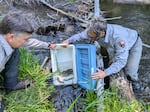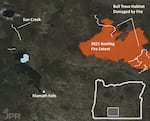
NPS Fish Biologist Dave Hering (right) and Fisheries Technician Michael Scheu release the bull trout into Sun Creek, above the dams that keep non-native fish away, July 10, 2024.
Roman Battaglia / JPR News
At a small dam on Sun Creek made out of corrugated vinyl sheeting, National Park Service fish biologist Dave Hering shuts off water leading into a metal box the size of a small elevator.
Michael Scheu, one of Hering’s team members, climbs inside. Surrounding his feet are twelve bull trout. They got trapped here trying to head upstream. Scheu collects half of them in a black bucket, handing it off to another team member above.
Bull trout are the only remaining native fish species in Crater Lake National Park. They used to be found all over the Klamath Basin, Hering says, including nearby Fort Creek.
“Fort Creek is a place where a bull trout was sampled in the 19th century and actually held in the Smithsonian,” says Hering. “And for decades, including the whole first 15 years of my career here, we didn’t have bull trout there anymore.”
Competition killed the trout
Competition from a closely related cousin, the brook trout, introduced for fishing in the early 1900s, was the primary factor leading to bull trout being listed as threatened under the Endangered Species Act in 1998.
Native to the eastern U.S., brook trout evolved with slightly different traits that allow them to outcompete the bull trout in its natural habitat. They mature at a younger age, thereby producing more eggs over a longer period of time than bull trout, among other advantages.
In 1989, scientists found a disturbingly small number of bull trout high up Sun Creek, inside the national park. Mark Buktenica is the now-retired fish biologist for the park service who began the effort to save the species.
“The National Park Service mandate from Congress is pretty clear,” Buktenica said on a 1999 episode of Oregon Field Guide. “We’re supposed to preserve and protect these ecosystems in their natural condition. Well, the natural condition for Sun Creek is to have resident bull trout.”
Back then, Buktenica and his team built two dams on Sun Creek to prevent non-native fish from getting further upstream. Then, they used a specialized poison to kill any brook trout upstream of the dams.
Hering took over Buktenica’s work when he retired in 2017. He says he’s gotten more and more invested since their population has grown in number.
“A lot of people — anglers and fish enthusiasts — describe it as sort of an ugly fish or one that isn’t as nice to look at as some others. But I think they’re beautiful,” Hering says.
Hering was there when, in 2017, scientists reconnected Sun Creek to the Wood River for the first time in over 150 years. The tributary had been isolated on private land and used for irrigation, cutting bull trout off from other parts of the Klamath Basin.
A rare recovery
Retired Southern Oregon University aquatic ecologist Michael Parker says most successful endangered species recovery programs share a few core ingredients: extensive knowledge of the species and its habitat, collaboration with other government agencies and getting private landowners on board.
“Getting all those together to align in a way that then you can start doing the restoration work and the recovery work, I don’t think that comes together all that often,” Parker says. “And that’s why this is such a special case.”
‘Species in many cases have the ability to take care of themselves.’
According to the U.S. Fish and Wildlife Service, 736 animal species are listed as either threatened or endangered. Fewer than 50 have been taken off the list because they’ve recovered. Two include the bald eagle and the gray whale. Another 32 species have gone extinct since being listed.
Bjorn Erickson oversees the conservation of around 300 endangered plant and animal species in California, Nevada and the Klamath Basin region. He says he’s seen a growing number of recoveries in recent years. He says removing the threats that caused the species to decline in the first place is what leads to success.

The extent of bull trout habitat in the Klamath Basin, according to the USFWS (in white and blue). A large portion of their habitat was impacted by the 2021 Bootleg Fire. Data/Imagery: USFWS, NIFC, NASA.
Roman Battaglia / JPR News
“I think what it demonstrates is if we can do a good job of getting rid of the threats that have been acting on species and the things that have caused them to decline historically, then species in many cases have the ability to take care of themselves,” Erickson says.
He says a similar recovery to bull trout happened with a number of plant and bird species on San Clemente Island off the coast of Los Angeles. The Fish and Wildlife Service worked to remove non-native herbivores, including goats, deer and sheep that were introduced to the island for grazing.
Once those species were removed in the ‘90s, the native vegetation rebounded, as well as the San Clemente Bell’s sparrow. Those species were taken off the Endangered Species List in 2023, a few decades after the recovery work took place.
“There’s inherently going to be a lag between when something is listed, and when we can take it off the list because it’s recovered,” Erickson says. “We need to restore habitat, we need to protect habitat, eliminate other threats.”
Star treatment
The bull trout Hering’s team collected in the trap at Sun Creek are taken to a mobile lab set up in the bed of his pickup. Then, they’re weighed, measured, and get their picture taken.
They’re hoping the pictures can be used to identify individual fish in the future using machine learning, the same way that social media platforms like Facebook can recognize your face.
“Now that I’m looking at the pictures, processing through them, it’s like, ‘Oh yeah, you can see that one is totally different.’ It has its own constellation of spots that’s different from any other fish you see out there,” says Scheu, the fisheries technician.
The fish then have a small radio-frequency tag implanted near their dorsal fin, which can be tracked with sensors that are placed throughout the creek. That data shows bull trout have grown exponentially since Sun Creek was reconnected to the Wood River.
Hering says when they first ran this migration trap in 2021, they caught just 16 bull trout all year.
“I was just ecstatic. I thought, ‘Wow this is amazing! We’ve got 16 bull trout!’ The next year we caught 35 fish in the trap,” Hering says. “And that was even better. It was like, ‘This is really cool, things are working.’ And then last year, 2023, we ended up catching 185 bull trout in the season.”
They’ve already caught 203 fish this year, with months left to trap even more.
After tagging the fish at their mobile lab, the bull trout are loaded into a cooler and driven upstream above the dams where researchers have killed off non-native brook trout.
Repopulation
The Sun Creek bull trout will help create a reservoir of fish that can be used to help repopulate other places, Hering says.
“Many of us who are working on this in this area don’t really have the patience to just watch them do the rest of the job to repopulate the basin,” he says.
Historically, bull trout in the Klamath Basin were much more interconnected with each other. But, as the landscape was altered for irrigation and other purposes, they became isolated in small pockets around the basin.
“The biggest threat to small, isolated populations is the fact that some unpredictable environmental catastrophe or perturbation can take place that can wipe out an entire population,” says Parker, the SOU ecologist.
An example of this threat happened when the 2021 Bootleg Fire northeast of Klamath Falls damaged a number of the remaining bull trout populations in the basin.
“If they were all connected, those areas that would have fires could be recolonized,” Parker says.
Bull trout can be found in other parts of the Pacific Northwest. But, according to the 2015 bull trout recovery plan from the USFWS, the Klamath Basin population is the most imperiled. That plan also estimates that recovery for this area could take 50-70 years and cost almost $38 million.
Hering is working on a project starting this year to manually move bull trout from Sun Creek to other tributaries to jumpstart their reintroduction.
He says the only way to allow bull trout to survive long-term without intervention is by removing non-native brook trout from the entirety of the Klamath Basin.
“If we remove them from a few places where it’s important to do that, to preserve native species, maybe that’s a cost that we’re willing to pay,” says Hering.
He says while anglers are banned from catching bull trout in the Klamath Basin right now, with continued recovery they may be able to start catching them again.
But, the technology to remove brook trout from the basin likely isn’t available yet. That would have to include the entirety of the around 64,000-acre Upper Klamath Lake, the largest freshwater body in Oregon by surface area.
“It’s a difficult job even in a simple place,” Hering says.
Still, he says the success they’re seeing with bull trout shows the dedication needed to help species recover.
“To my mind, when something’s listed under the Endangered Species Act, that shouldn’t be sort of a mark of distinction as the thing blinks out of existence,” Hering says. “It oughta be a call to action to actually do something.”